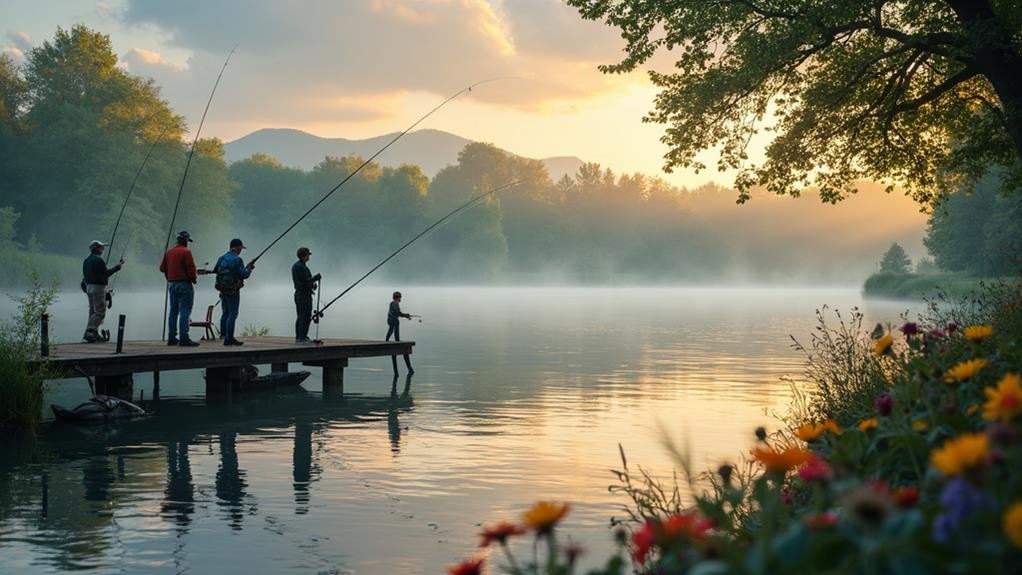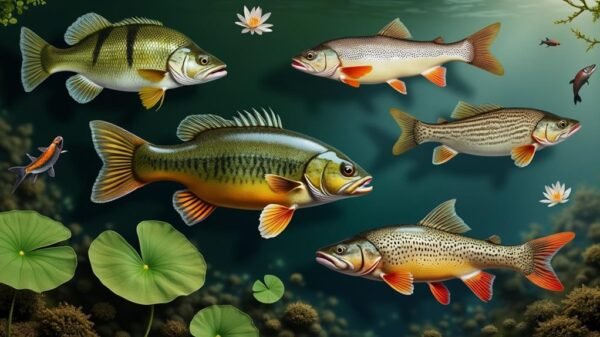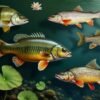If you're fishing in local lakes, knowing the top 10 freshwater fish can improve your success! You'll often find largemouth bass, known for their size and aggressive behavior, alongside the speedy northern pike. Crappie and bluegill swim in schools, making them a fun catch. Rainbow trout add vibrancy to your line, while channel catfish offer a unique challenge with their whiskers and taste. Other notable mentions are sunfish, perch, and walleye. Understanding their habitats and behaviors will elevate your fishing skills, ensuring you're well-prepared for your next trip. Stay tuned for insights on finding and catching these amazing fish!
Overview of Freshwater Fish
When you explore local lakes, you will discover a variety of freshwater fish that play a vital role in the aquatic ecosystem. These species, such as largemouth bass and crappie, exhibit different shapes, sizes, and colors, each uniquely contributing to their environment. For instance, bass and trout are popular catches among anglers, and they help control the populations of smaller fish and insects.
Sunfish and catfish often inhabit the peripheries of lakes, serving as food for larger predators and maintaining ecological balance. Whether you're fishing with a Shimano rod or simply observing, it's fascinating to witness how these fish interact with their surroundings.
Every fish species displays unique behaviors, ranging from mating rituals to foraging techniques. Visiting local lakes allows you to appreciate this vibrant underwater ecosystem.
Pay attention to their habitats and the surrounding vegetation, as these elements are interconnected. Gaining insight into these relationships reveals the intricate web of life thriving beneath the surface. So grab your gear, head to the lakes, and immerse yourself in the captivating world of freshwater fish waiting for you.
Fish Habitats Explained

Fish habitats vary greatly and are crucial in sustaining the different species found in local lakes. You will discover that these ecosystems range from shallow, sunlit zones to deeper, cooler areas. Each environment provides distinct characteristics that fish rely on for sustenance, refuge, and reproduction. Gaining knowledge about the basics of freshwater angling can assist you in identifying these habitats more efficiently.
In the shallow regions, you may find aquatic plants such as cattails and water lilies. These vegetation types offer protection and attract insects, creating a prime feeding ground for fish. As you explore deeper waters, you might notice gravelly or sandy substrates, which are favored by species that like to hide and hunt.
Familiarizing yourself with these habitats can enhance your fishing endeavors. For instance, when pursuing largemouth bass, seek out spots with structure, such as downed timber or submerged boulders. In contrast, rainbow trout prefer cooler, flowing water, typically located near the inlets or outlets of the lake.
Be mindful of seasonal shifts, as fish frequently migrate between habitats in response to temperature and food supply. By understanding these diverse environments, you will gain a greater appreciation for the intricate balance of life in local lakes and maximize your fishing experiences. So, prepare your gear and embrace the adventure of exploring these aquatic realms.
Identifying Key Characteristics

When you're out by the lake, spotting different freshwater fish can be a fun challenge! Pay close attention to their color patterns and markings, as these can help you identify diverse species. Many fish, like the Largemouth Bass, have distinctive features that set them apart. You'll also want to note their body shape and size, which are key traits that distinguish one fish from another
Color Patterns and Markings
Color patterns and markings are essential for distinguishing various freshwater fish species in local lakes. When fishing or observing, it's important to focus on these unique traits. For example, the striking stripes of a yellow perch can easily attract your attention, while the speckled body of a brook trout may leave you mesmerized. Each species presents a unique color palette that can shift with the seasons or as they grow. Using lifelike fishing lures that replicate these realistic patterns can enhance your chances of identifying and catching these fish.
Take a moment to examine the colors closely. The bright oranges and yellows of a sunfish stand out against the darker blues of a bluegill. Some fish, like the northern pike, feature spots or bars that help them blend into their environments, providing camouflage. This adaptation not only supports their survival but also turns identification into an enjoyable challenge for anglers and enthusiasts alike.
Body Shape and Size
Identifying various freshwater fish in local lakes requires observing their form and dimensions. These characteristics reveal much about the species. For example, a fish with an elongated, sleek physique, such as the Northern Pike, is designed for rapid movement. This form enables it to swiftly navigate through water, establishing it as an effective predator. Similarly, the form of a Largemouth Bass showcases its role as a principal predator in freshwater environments. In contrast, the rounder physiques of Bluegills and Sunfish promote stability and agility in confined areas, ideal for capturing insects.
Dimensions are also crucial. Smaller fish, like Minnows, often gather in schools, whereas larger species, such as Bass, usually hunt alone. When observing a sizable fish, consider its width along with its length. A robust fish may indicate a rich habitat teeming with nourishment.
Largemouth Bass

Largemouth bass represent a popular target for freshwater fishing enthusiasts. Known for their fierce temperament and substantial size, these fish rank among the most plentiful aquatic species worldwide. Anglers seek them out for thrilling fishing experiences. Weighing over ten pounds and reaching lengths of up to twenty-five inches, catching a largemouth bass is a notable achievement for any fisherman. They inhabit various environments, including lakes, rivers, and ponds, often lurking in vegetation or beneath submerged objects.
To boost your chances of catching a largemouth bass, utilize topwater lures from brands like Rapala or Zoom plastic worms. Early morning and late evening are prime times for fishing, as these predators exhibit heightened activity during these hours. Upon sensing a strike, promptly set the hook! For optimal results, explore effective fishing techniques that attract these fish.
Always verify local fishing regulations concerning size restrictions and catch-and-release guidelines. Adhering to these rules promotes sustainable populations for all anglers.
Whether you are an experienced fisherman or a beginner, targeting largemouth bass can be an exhilarating endeavor. So gather your fishing equipment, visit your nearby lake, and embrace the adventure! You never know when you might hook that trophy fish that turns your outing into a memorable one.
Northern Pike

When you're out fishing, you might encounter the fierce northern pike, an exhilarating catch for any angler. This predatory fish can reach lengths of up to 40 inches, featuring razor-sharp teeth and a distinct elongated body. Typically, you'll find these predators lurking in weedy areas of lakes and rivers, poised to ambush their next prey. As a cool-water fish species, northern pike thrive in various freshwater habitats, making them a popular target for sport fishermen.
To hook a northern pike, opt for large lures that imitate the movements of smaller fish. Brands like Strike King and Rapala offer excellent spinnerbaits and swimbaits that effectively attract pike. Be sure to attach a steel leader to your line to safeguard against those formidable teeth!
The ideal times to target northern pike are during the early morning or late evening when they exhibit heightened activity. Patience is essential; you may need to cast your line multiple times before securing a bite.
Once you've hooked one, brace yourself for an exhilarating struggle! Northern pike are renowned for their fierce fights, ensuring that every catch is a memorable adventure. So gather your tackle, head to your favorite fishing spot, and relish the excitement of pursuing this iconic freshwater predator.
Bluegill

When you ponder fishing in local lakes, bluegill is a fantastic option to delve into. These colorful fish thrive in warm, shallow waters and are known for their unique feeding habits, making them a fun challenge for anglers. To increase your chances of success, remember to organize all fishing gear ahead of time and prepare a bait bag in advance. Let's investigate where you can find them, what they like to eat, and the best techniques to reel them in.
Habitat and Distribution
Bluegills thrive in a range of freshwater environments, making them a favored target for anglers. These spirited fish inhabit lakes, ponds, rivers, and reservoirs throughout North America. They prefer shallow areas rich in aquatic plants, as these provide essential cover and safety. Diverse collections of freshwater fish highlight the importance of these habitats for bluegill survival and reproduction. When fishing, focus on locations near submerged vegetation, rocky outcrops, or fallen timber—these are prime spots for bluegills, often ready to bite.
Bluegills exhibit remarkable adaptability, so encountering them in both clear and turbid waters is common. They can tolerate various water temperatures, but they excel in warm, sunny conditions. For an exciting fishing excursion, explore different lakes and ponds; bluegills are nearly ubiquitous.
These fish often school together, enhancing the excitement of your fishing experience. As you cast your line, remember that bluegills are most active during the early morning and late afternoon. Prepare your gear and visit local waterways to engage with these remarkable fish. The excitement of catching bluegills can spark a lifelong passion for fishing.
Feeding Habits
In their natural environments, bluegills display diverse feeding behaviors that enhance their appeal to anglers. These freshwater fish are opportunistic eaters, consuming whatever food sources they encounter. Common snacks include insects, zooplankton, and small crustaceans, making them responsive to various types of live bait. In the cooler hours of mornings and evenings, bluegills become more active, swiftly moving to catch their prey.
To successfully catch bluegills, it's essential to comprehend their feeding patterns. During summer months, they often seek shelter near structures such as rocks, aquatic plants, or submerged logs, where food is abundant. Observing the surface for rising fish can indicate their pursuit of insects, so watch for any disturbances.
For bait, options like Nightcrawlers or Berkley PowerBait Micro Jigs are highly effective. Bluegills are particularly fond of these enticing offerings! Adjust your fishing strategy according to the time of day and water temperature. By aligning your tactics with their feeding habits, you'll boost your chances of landing that next big catch. Get ready to enjoy the excitement of fishing while exploring local lakes and waterways.
Fishing Techniques
Many anglers discover that employing particular fishing techniques significantly improves their chances of catching bluegills. One effective method involves using a lightweight fishing rod and spinning reel with a 4-6 lb test monofilament line. Bluegills typically inhabit shallow waters, especially near structures like lily pads or submerged logs. Various freshwater species found in lakes and ponds can offer unique fishing opportunities, so cast your line close to these areas and allow it to sink slightly before reeling in slowly.
Utilizing live bait, such as nightcrawlers or crickets, is another successful strategy. Bluegills are known for their nibbling habits, so a small hook paired with lively bait can yield great results. For those who prefer artificial lures, brands like Rapala and Mepps offer small jigs or spinners in eye-catching colors that can attract bluegills and pique their interest.
Timing your fishing trip is essential as well. Early mornings and late afternoons are prime times when bluegills are most active. Pay attention to the weather; overcast conditions can be particularly favorable for fishing since bluegills often feed more during such days.
Lastly, patience is key! Bluegills may take their time to bite, but with the right techniques, you'll reel in impressive catches. Embrace the joy of fishing and cherish every moment spent on the water.
Crappie

Crappie, a popular species among anglers, flourish in regional lakes and provide an exciting fishing adventure. Known for their delicious flavor and lively struggle, these fish often swim in schools, enhancing your likelihood of a successful catch. As one of the more accessible fish to hook, particularly black crappies, they cater to novice anglers as well. If you're eager to land some crappie, consider these three strategies to boost your success:
- Pick Optimal Times: Dawn and dusk are ideal periods to fish for crappie. They exhibit heightened activity during these hours, raising your chances of a strike.
- Choose Effective Bait: Live minnows and jigs from brands like Zoom or Berkley are extremely effective. Try different colors and sizes to discover what attracts them. Keep in mind, crappie can be discerning!
- Locate Their Environment: Search for crappie near submerged habitats like fallen timber, brush piles, and aquatic vegetation. These areas offer shelter and attract prey, making them prime fishing spots. Other freshwater species often gather in these regions as well.
With these tactics in hand, you can revel in the thrill of crappie fishing. So prepare your equipment, visit your nearby lake, and embrace the adventure that comes with catching this prized fish! Happy fishing!
Rainbow Trout

Rainbow trout, a favorite among anglers, are known for their vibrant hues and energetic struggle. These fish display stunning features, including bright pink stripes and iridescent scales, while also providing an exciting challenge when caught. As a rich source of lean protein and omega-3 fatty acids, rainbow trout are both tasty and nutritious, making them a sought-after catch. For those seeking adventure, fishing for rainbow trout is an ideal option.
To successfully catch rainbow trout, scout local lakes with cool, transparent waters. The early morning and late afternoon hours are optimal, as these fish exhibit increased activity during these times. Utilize lightweight fishing gear for enhanced control, and select lures such as Mepps spinners or Acme spoons, which mimic the natural prey of the trout. For a more exhilarating experience, consider fly fishing—it's a fantastic way to immerse yourself in the great outdoors.
Channel Catfish

If you're seeking a unique angling adventure, channel catfish might be your ideal target. Recognized for their distinctive whiskers and formidable struggle, these fish can add thrill to your fishing excursions. Channel catfish are not only enjoyable to reel in but also tasty on your plate, making them a favored option among fishermen. They belong to the coolwater fish category, typically residing in lakes and rivers, providing accessibility for many fishing enthusiasts.
To boost your likelihood of catching one, consider these three strategies:
- Bait Choice: Channel catfish are drawn to pungent baits such as Berkley PowerBait, chicken liver, or nightcrawlers. Try various options to determine what attracts the catfish in your local water body.
- Fishing Method: Employ bottom fishing methods with a slip sinker rig to keep your bait close to the substrate, where catfish usually patrol. Patience is crucial, so prepare for an exhilarating battle!
- Optimal Timing: Catfish show increased activity during the twilight hours of dawn and dusk. Scheduling your outings around these times can enhance your chances of a successful catch.
Best Practices for Anglers

When you're out on the water, having the right gear can make all the difference in your fishing experience. Understanding the significance of structures for freshwater fishing can also improve your chances of success. It's also essential to practice ethical catch and release to help keep our local lakes thriving with fish. Plus, staying informed about local regulations guarantees you're fishing responsibly and protecting the environment for future anglers.
Proper Gear Selection
Selecting the appropriate fishing gear is crucial for a successful trip, impacting your overall experience significantly. When you venture to local ponds, it's essential to ensure your equipment aligns with your fishing objectives. The right freshwater fishing tools can enhance your time on the water, especially when pursuing specific species like bass or trout. Here are three essential components to consider:
- Fishing Rod and Reel: Opt for a rod that fits comfortably in your grip. A medium-action rod, such as those from Ugly Stik, offers versatility for various species, while a Shimano spinning reel allows for easy handling of different line types.
- Fishing Line: The choice of line is vital. For general use, monofilament lines like Berkley Trilene are excellent, but if you're targeting larger species such as pike, consider using PowerPro braided line for its superior strength and sensitivity.
- Baits and Lures: The effectiveness of your bait depends on the target species. Live bait, such as nightcrawlers, can be very effective, but brands like Rapala offer artificial lures that effectively mimic the movements of prey. Additionally, using high-quality Gamakatsu freshwater fishing hooks can significantly increase your chances of landing a catch.
Ethical Catch and Release
Ethical capture and release practices are essential for maintaining fish populations and supporting thriving ecosystems in regional bodies of water. When you land a fish, handle it with care. Employ barbless hooks; they simplify the release process and minimize harm. Additionally, using lifelike lures such as the Strike King KVD Swimbait enhances your fishing experience while encouraging sustainable angling practices. If a landing net is necessary, opt for a rubber version—this choice reduces injury to the fish's skin and scales.
After catching a fish, keep it submerged as much as possible. If a photograph is desired, do so swiftly. Wet your hands prior to touching the fish to preserve its protective slime layer, which is crucial for preventing infections. When it's time to release the fish, hold it gently, orienting it into the current. Move it back and forth to aid in its recovery.
Local Regulations Awareness
Understanding local regulations is crucial for ethical catch and release practices. When enjoying fishing in nearby lakes, being aware of the rules ensures safety, knowledge, and environmental respect. Utilizing tools like the Fishbrain App allows anglers to access real-time freshwater regulations specific to their area. Here are three essential practices for staying informed about local fishing regulations:
- Verify License Requirements: Before casting your line, ensure you possess the necessary fishing license. Various lakes may have distinct requirements, making verification important.
- Know Species Limits: Familiarize yourself with size and bag limits for local fish species. This knowledge helps prevent overfishing and supports the sustainability of fish populations.
- Monitor Seasonal Regulations: Fishing seasons can differ among species. Regularly reviewing regulations is beneficial, as they may change due to conservation efforts.



























